Saturday, October 2. 2010
No serious person takes analogies as accurate. Politicians and journalists are often not serious people, seeking self-serving soundbites and sensationalism over careful knowledge of the facts.
This lure is attractive for those who trot out the US experience in Vietnam, particularly the 1968 Tet Offensive, to advocate hopelessness for our and target countries’ battles against insurgents. US misreporting of the wholesale defeat of communist forces – losing 45,000 of the 84,000 attackers – and feckless US policymakers failing to carry-through, serves as the template current foes rely upon.
Among many examples provided by Robbins:
Osama bin Laden wrote to Taliban leader Mullah Omar, “It is obvious that the media war in this century is one of the strongest methods; in fact, its share may reach 90 percent of the total preparation for battles.”
So author James Robbins, in This Time We Win: Revisiting The Tet Offensive, takes 301 pages plus copious footnotes to “unlink the power of analogy from the terrorist arsenal,” by detailing every aspect of Tet ’68 and its aftermath.
This ground has been well-plowed before.
It’s not new news that the US media was grossly biased and inept in its reporting of Tet ’68.
Continue reading "Review: This Time We Win (Or Do We?). Tet Revisited"
Sunday, September 19. 2010
Via NRO:
Mao Zedong, founder of the People’s Republic of China, qualifies as the greatest mass murderer in world history, an expert who had unprecedented access to official Communist Party archives said yesterday.
Anything can be justified by "greater good" Utilitarianism. More from John at Powerline.
Thursday, September 16. 2010
Came in over the transom with the video:
 The P51 was the most versatile fighter plane of WW2. It excelled at both ground level support of the troops and high altitude long range fighter cover for the heavy bombers. It was the equal of the best fighter planes in dog fights. It was also an accident of fate or timing rather than planning that it existed. The P51 was the most versatile fighter plane of WW2. It excelled at both ground level support of the troops and high altitude long range fighter cover for the heavy bombers. It was the equal of the best fighter planes in dog fights. It was also an accident of fate or timing rather than planning that it existed.
In late 1940 or early '41 Britain was desperately short of fighter planes of any sort and had sent some RAF people to the US to see what they could buy. Hoping for some P-40's they talked with Curtis Wright and found them booked up for the duration by the US govmt. They got a tip from Curtis Wright that North American Aviation had no contracts yet and was looking for business, and that Curtis Wright would licence North American to build P-40's if they worked out an agreement. When the RAF asked the North American small management crew if they would be interested their answer was Why do you wand to buy an expensive, high priced obsolete plane that would take well over a year to start any production when we have a new design worked out and can have a prototype ready for RAF test flights in 9 months if you can get us an engine for it from Allison. They were, they could and they did a deal and were very happy with the performance of the prototype, and placed a production order.
When this news worked its way through to the Army Air Force they decided to look into the possibilities and eventually ordered a production run that wound up as the A-36 low level fighter. The Allison V12 was the only non-radial combat aircraft engine built in the USA and, unlike the Rolls Royce Merlin engine and the German ME bf109, it did not have a supercharger which was essential for combat above 15,000 ft as well as top performance at lower altitudes. After the RAF had a few month's experience with the new plane, the RAF did the obvious thing and grafted a Rolls Royce Merlin engine from a Spitfire onto one of their "P-51's" (don't remember what the RAF called their version of the plane). At this time the RAF got the North American crew on board the update and they soon found out that Packard Motor Company in the US was building Rolls Royce engines for the PT Boats of the Navy. Packard was happy to add Merlin egines for NA to their production runs and the P-51 was officially launched.
One of the benefits of NA being small and nearly broke was that the design engineers had to do double duty as production engineers so they designed the plane for simple and fast as well as low cost production. At that time the conventional practice was to build the airframe and then have people crawl inside to string all the wires and cables together, and this more than doubled the assembly time and cost. NA designed the fuselage in two half shells and had the electrical, hydraulic and control cables, etc installed in each half prior to sewing the halves together. The P-51 cost about one third the cost of the P-38 and about half the cost of the P-47 or F6F Navy planes.
The video here: http://www.asb.tv/videos/view.php?v=1bf99434&br=500
Wednesday, September 15. 2010
One of my grandpas used to love to visit Cuba for vacation getaways. Cigars, cocktails, lovely women, and great sport fishing. Here's an idea of what Havana was like, before the Commies destroyed it. Prosperous, clean, lively, and free. Now it's a dump.
This footage ought to be enough to persuade even the most loony Lefty, especially since even the Castro brother thugs are walking back Socialism this week...but it won't.
Tuesday, September 7. 2010
The Austrian Adolf Hitler spent a few years just over the border in Passau in youth before his parents moved back to Linz, but there are no signs there bragging about it. He spoke the Southern Bavarian dialect which is used in north Austria and southern Bavaria (there are apparently many German dialects).
I got onto that topic because, having recently returned from that part of the world, I was checking out the Anschluss, the 1938 "joining" of the short-lived Republic of Austria (short-lived since the Hapsburg's Austria-Hungary fell apart after WW1) with Germany. From what I have read, this event was welcomed by many Austrians - but what do I know? It was certainly not welcomed by the Jews of Vienna.
The Anschluss is part of the story of European - and American - appeasement of aggressive expansion and control. Not a shot was fired and a vote, of sorts, provided some legitimacy. Today, the EU is trying to do it, but with paper not armies.
The history of Europe, since Roman times, is one of things being pulled together, then coming apart. It will be the same with the EU. Anschluss.
Friday, September 3. 2010
I dedicate this post to our pal Sippican, who knows a lot more about archeetekcher than I do.
What does Pope Benedict have to do with Regensburg? Plenty.
Plus the town is Germany's medieval gem (and was not bombed by the Allies). It would be a very pleasant town to live in.
The great gothic St. Peter's (c. 1240) is fine, but we found this small parish church, not a tourist site, Ulrichskirche (also 1200s I believe), which is next door to the cathedral, interesting from a detective standpoint. Take a look at the bastardised architecture and decor.
What first struck us on entering was that the church organist was practicing, noodling on his old German pipe organ with comfortable recessional noises. Great.
Second thought was "What the heck is this?"
Well, clearly somebody in the 1700's decided to gussy up the old-fashioned, gothic-ish church with Baroque. Redecorating. Squared the old columns, added squigglies to them, new baroque pulpit, and painted over the old gothic paint and stone.
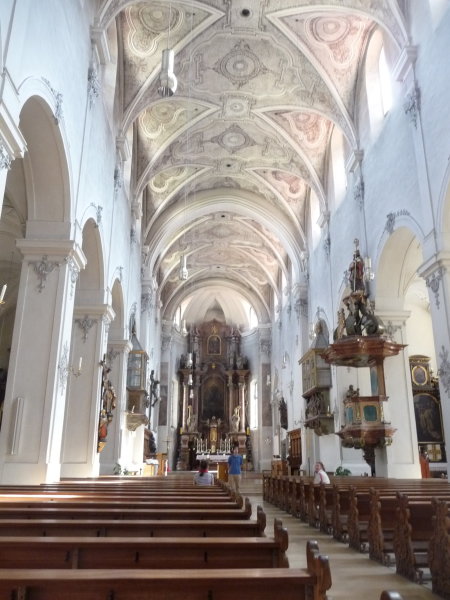
More interesting architectural detail below the fold -
Continue reading "St. Ulrich's and architectural fashion"
Tuesday, August 31. 2010
Don Juan's Dad was Holy Roman Emperor Charles V of Austria. His Mom was Barbara Blomberg, a local singer who entertained Charles with music and fun while he passed through Regensburg in 1546.
Not much more is heard in history about Barbara, but we are grateful to her for bearing John of Austria, who led the allied navies against the Ottomans at the Battle of Lepanto in 1571.
It is believed that John was conceived during a one-night-stand in this old hotel in Regensburg (yellow one on the right, a week or so ago). An historic little hook-up indeed:

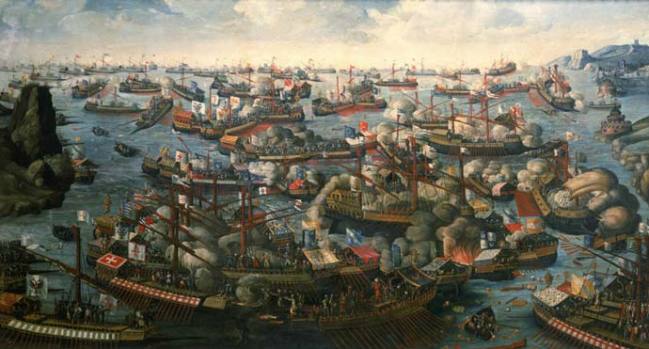
Sunday, August 29. 2010
 One place we did not get to on our trip was Salzburg. Wish we had had time to visit that medieval city which, as its name implies, got rich selling and transporting salt down the river. One place we did not get to on our trip was Salzburg. Wish we had had time to visit that medieval city which, as its name implies, got rich selling and transporting salt down the river.
Our guide pointed out to us how important salt was at the time - not as a condiment, but as a food-preservative. "White gold."
I wonder what salt mines were like in 1400.
Thursday, August 19. 2010
 I have a friend who is a bit of a watch collecter and amateur expert. He showed me the Vacheron Constantin watch he was wearing the other day. I have a friend who is a bit of a watch collecter and amateur expert. He showed me the Vacheron Constantin watch he was wearing the other day.
It's the oldest surviving watch company in the world. Est. 1755. They make unostentatious fine watches, or "timepieces" as watch snobs term them. You have to wind them every morning which, if I understand it right, all very fine watches require.
I am a Timex guy - a watch I wear routinely needs to take plenty of abuse and needs to be disposable - but I have a couple of somewhat fancier watches which I rarely use. Consumption is not one of my hobbies (I don't own a lot, but I have enough of everything), but I can appreciate fine hand-made things.
My friend tells me that Obama wears a flashy and expensive IWC, assembled from innards made by other companies. "Typical Obama," said he.
Photo is a Vacheron Constantin Jubilee.
Wednesday, August 18. 2010
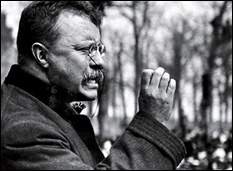 In my opinion, after all is said and done, there has really only been one president of the United States who in his heart was one of us, the lowly we, the people. In my opinion, after all is said and done, there has really only been one president of the United States who in his heart was one of us, the lowly we, the people.
Teddy Roosevelt.
Oh, it could be argued that the Humble Log Cabin Crowd — Abe Lincoln springs to mind — were "one of us", but they all became that most horrid of things, politicians, once they achieved national status. Teddy, alone, never forgot we, the people.
Yeah, ol' TR. He was a Republican, right? Oh, of course he was. One of the most famous Republicans in history! Why, just look at some of his Republican platforms!
— Break up Big Business
— Give Big Labor national power
— Deplore the difference between the rich and poor
— Push for national health care
— Push for national workman's comp insurance
And, if those heinous crimes weren't enough, check this out!
— Give women the right to vote
Scandalous! That's what happens when you let a RINO take power, folks!
But then...
But then, at the time, the country really needed such progressive ideals. Some of the big business barons, alone, were pulling in more cash per year than the federal government, and big business was on a path to monopolize the only means of mass transportation in the country, the railroads. That's simply too much power in the private sector and Roosevelt correctly put an end to it.
He also put an end to the idiocy of women not voting, and he honestly tried to ease the plight of the black man through legislation, but society simply wasn't ready for a Civil Rights-type act. This was only two generations removed from the Civil War, so the South was still, in great part, the South.
And while he was never able to implement his national health and insurance programs, he did raise working conditions for the average slob considerably. This was in an era of mandatory 12-hour work shifts and child labor, both of which he abolished.
 He also racked up a number of global accomplishments, such as building the Panama Canal, sending our fleet of battleships around the world to establish ourselves as a world power (the first time a nation had ever done so), and what really put our fledgling nation in the big leagues was his negotiating an end to the bloody Russo-Japanese War, something no diplomat alive thought possible. He also racked up a number of global accomplishments, such as building the Panama Canal, sending our fleet of battleships around the world to establish ourselves as a world power (the first time a nation had ever done so), and what really put our fledgling nation in the big leagues was his negotiating an end to the bloody Russo-Japanese War, something no diplomat alive thought possible.
And no article on Teddy would be complete without mentioning how he brought the conservation of our natural resources into the public eye. In those days, most Americans viewed the country to be so vast that our resources were infinite, but TR saw otherwise. He strongly believed that we had the right to use the land, but believed just as strongly that we didn't have the right to waste it.
For your education, enlightenment and enjoyment, I highly recommend "Teddy Roosevelt: An American Lion", available on Netflix and presumably Blockbuster. It's reasonably even-handed, pointing out his mistakes as well as his victories, and does a decent job of putting things in historical perspective. As I noted above, when you start listing out his platforms, he sounds shockingly liberal, yet at the time it was exactly what America needed.
America being we, the people.
Friday, August 13. 2010
 Finally, somebody remembered to give me this book for my birthday. Finally, somebody remembered to give me this book for my birthday.
Just need to finish reading my Baroque book first.
Does it seem to you that they keep making books with smaller and smaller print these days...?
Thursday, August 12. 2010
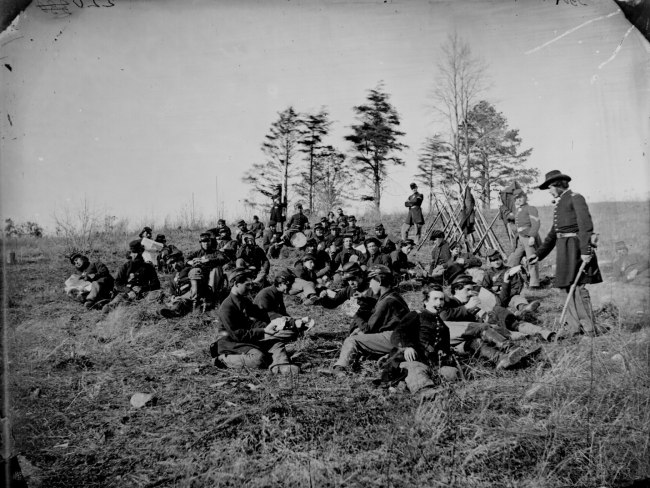
Discussions about what "caused" the Civil War never end. From Wilson Quarterly, A century and a half after the first state seceded from the Union, a lively debate over what caused the Civil War continues. A quote:
Whether or not they owned slaves, Southerners almost universally professed the doctrine known then and now as states’ rights, grounded in the federal system as originally understood, at least by the followers of Thomas Jefferson. When the South lost, states’ rights lost with it, and the unquestionable supremacy of the central government has been with us ever since. That abstract phrase “states’ rights” as used before the Civil War immediately prompts the question, states’ rights to what? “The right to own slaves,” McPherson explains, “the right to take this property into the territories; freedom from the coercive powers of a centralized government.”
States' rights were and are about lots more than slavery. It's a historical tragedy that slavery and Jim Crow ended up being the poster children for states' rights. The war was a mighty tragedy too.
Sunday, August 8. 2010
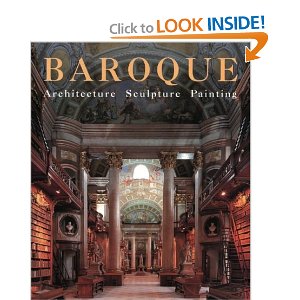 Instead of turning up my nose at Baroque design, I decided to try to get into the heads of those who promulgated this heavily-ornamented style from around 1600 to 1750 in Europe. Instead of turning up my nose at Baroque design, I decided to try to get into the heads of those who promulgated this heavily-ornamented style from around 1600 to 1750 in Europe.
Aside from some Italian kitsch, nobody has done new baroque for a long time. This remarkable book, Baroque: Architecture, Sculpture, Painting, despite its abundance of photos, is not a coffee-table book. It is dense with text and scholarly detail, and 500 pages of small print which tests my eyes. There is no way I will complete this before I arrive in Vienna, but I will give it the old college try.
One idea which is coming through clearly is the notion of "the world as a stage." Baroque design is meant to be a stage set. It was meant to impress and/or intimidate and/or inspire - to convey power and wealth, but also to provide a grandiose setting for the highly formalized interactions and occasions of the high classes of the time. It does that, however fussy, overdone, and gratuitously gaudy it may look to a modern eye.
Another feature of Baroque design is that it moves. It has curves, details that jump out; interiors can be a "blooming, buzzing confusion" (the term William James used to describe his speculation about the experience of a human infant).
Versailles, St. Peter's Square (which is a circle), and the Hofberg Library are some classics of Baroque. Baroque is sensual, indulgent, extravagant, maybe grandiloquent. Like Bach. Bernini's 1650 Ecstasy of St. Theresa contains most of the elements of Baroque, especially the melding of sensual art with the grand architectural design:
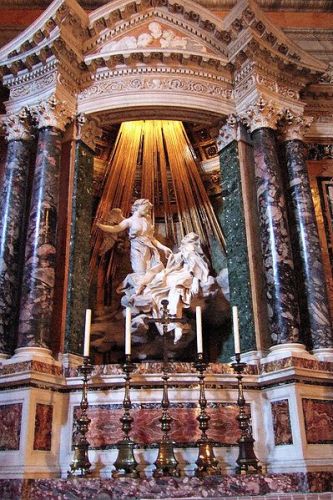
Here's a short list of the main elements of Baroque design.
Wiki explains how Baroque design has its roots in Mannerism, and how it was replaced, as a design fashion, by the aesthetic of Neoclassicism, which embraced restraint and cool "reason" as a reaction to a Baroque which had been taken to its limits.
We do not need to be enslaved to the aesthetic of our own time - or of any time. Baroque, however interesting, just isn't a Maggie's Farm, Yankee style. It's not in the blood.
Here's a Baroque era table, which I find both hideous and wonderful at the same time. It certainly moves, with those squigglies wiggling all over the inlay, and those sea slugs creeping up the legs:
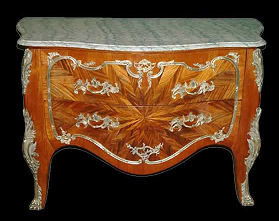
Tuesday, July 27. 2010
Good video summary of the American aircraft carrier. Most of our readers probably know it all, already.
Monday, July 26. 2010
As I always do before trips, I am catching up on history. This trip will be Vienna and the Danube. I view these places historically as the hinterlands, but you cannot fault their production of music in recent centuries. Music, wars, and sort-of hideous baroque architecture.
Vienna had been a Roman frontier outpost, but surely had been a barbarian settlement before that.
I do recall that European History in high school made my head spin from the endless alliances and endless wars and the reconfigurations of empires, kingdoms, duchies, principalities, and nations. With my ADD, it's a wonder I did so well with it. Forgot most of it. The War of the Spanish Succession.
I did not forget some details of the devastating Franco-Prussian War, but I certainly had forgotten that "German Austria" wanted to be part of Germany after WW1, but the Treaty of Versailles and the League of Nations forbade it. German Austria reached down into the (still) German-speaking areas of northern Italy. The Austria of today is a relatively brand-new nation (1945 or 1955 - pick the date) although it was a Babenburg duchy in 1156 and later was roughly the core of the Hapsburg's power for 640 years.
The Hapsburgs are credited with keeping the Ottomans out of Europe in 1683, but the King of Poland, Jan Sobieski, deserves lots of credit. There were 300 years of resisting the Ottoman Empire's invasions. I have never understood why Middle-Easterners coveted Europe, but they still do.
I find it amusing to think of what was going on in the wilds of the American colonies at the same time. Only Spain really cared, because of the gold. Otherwise insignificant except as pawns in larger European power games.
In the early 1700s, the Hapsburgs counted among their imperial control Belgium, Sardinia, Corsica, the Duchy of Milan, Naples, and Sicily. Two hundred years earlier, HRE "Emperor" Charles V in 1516 also happened to be King of Spain, bringing Spanish America, for a while, into the bounds of the Holy Roman Empire - such as it was: A crown, a flag, a bunch of castles and palaces, a title, and some truly snazzy outfits with fancy medals on them to impress the gals. Being King of Spain, on the other hand, was probably a cool gig with plenty of perks and babes.
The modern European nations are all younger in their configurations and their governmental structures than the US (except for the post-Empire island core of Britain).
One thought this perspective gave me is that the EU may be little more than an expanded reconstitution of the Holy Roman Empire - combined with the old Roman Empire. In time, it will pass too.
Photo below, Palace Schoenbrunn, first constructed as a hunting lodge in the early 1700s. "Hey, honey, have you seen where I put my camo and my ammo?"
That's from a time when royal governments lived off the labor of the people. Not like now, right?
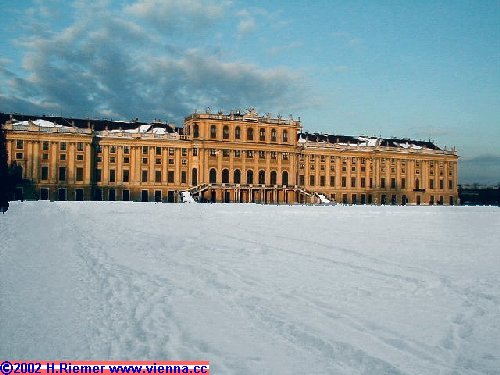
Sunday, July 25. 2010
While feasting on late after-dinner hazelnut gelati a little over a week ago in the relatively non-touristy lakefront village of Baveno, just up from the small piazza on the main drag, we were drawn to the sounds of a church choir, and sat on the stoop of the side door of the sanctuary for a half hour listening to them practice as darkness fell.
Nothing can make a 20-person choir sound like the Mormon Tabernacle Choir the way a small stone 900 year-old church can. Excellent group, too, with an exuberant organist.
Saint Gervaso is the patron saint of Baveno. Like many old buldings in Italy, the church was built of stone previously used in Roman buildings, some still bearing Roman markings and lettering. Recycling. We noted that they never took stones from the Roman bridges or aqueducts, though. Smart - and a conservative message.
This is no famous church, just an ordinary village church. Clearly pre-Gothic. The church and tower were built in around 1100 (but the front of the sanctuary was expanded a bit since then), the Baptistery in 1628, and the open hall of the Stations of the Cross probably in the 1700s, when Baveno became wealthy from its quarries of pink marble (which are still in use).
Palm trees right up there near the Swiss border.
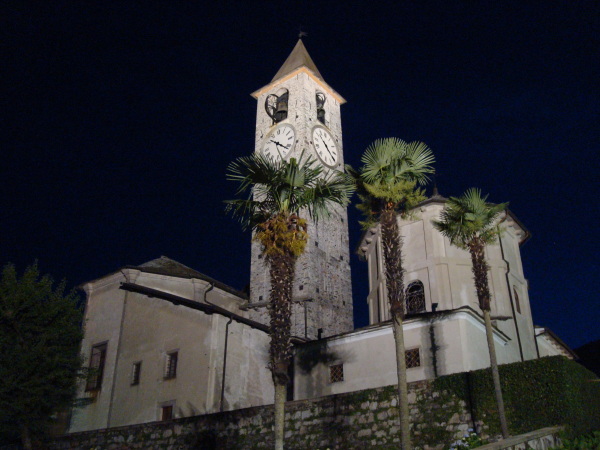
More photos of this small, unknown parish church below -
Continue reading "Santi Gervaso e Protaso: a re-post from 2008"
Wednesday, July 21. 2010
 From Classical: From Classical:
I saw a study once that in the US in the 1700s about 1/3 of the brides were already knocked up...
You want to do something about Western morality? Forget gays. The bigger hole is adultery and divorce. If we could bring back stoning for adultery and 40 lashes for fornication we might get somewhere. It all started going bad long before women got the vote. But it didn't help.
Grim has a good site but he appears to lack permalinks. Scroll down for Let's Make Sex a Lot More Heartless
Breitbart's dirty trick? Maybe dirtier than he realized. Says Lowry:
... her full speech is heartfelt and moving. It's the tale of someone overcoming hatred and rancor when she had every reason not to.
Sowell: Race Card Fraud
ADHD and marriage
What is being sold here?
Tenure is dying
Afghanistan 113 years ago
Pethokoukis: Just how high would taxes need to go?
Rabbi Shmuley: No Holds Barred: What's up with Tom Friedman?
Tiger: Health care "reform": What if the individual mandate is unconstitutional?
Are unemployment checks turning into welfare? Next step, permanent unemployment checks.
Political snobbery
Hungary's IMF revolt augurs ill for Greece (h/t EU Ref)
JournoList Members Discussed Whether the Government Should Shut Down Fox News. It's an ugly story. At Powerline, The Vast Left-Wing Journalists' Conspiracy
MAYBE we should hire the guys who run Wal-Mart to fix the economy.
Monday, July 19. 2010
It's fun to put history in context. A good piece on phlogiston theory.
One quote:
The Phlogistians were not a bunch of cranks. They were serious scientists who helped resolve some of the basic questions of chemistry, by being the devil's advocate against the Antiphlogistians, and by discovering important experiments. And, for almost the entire 18th century, the phlogiston theory was more satisfying than the alternative, in some ways. The Antiphlogistians deduced that combustion was when a substance combined with oxygen (Priestley's dephlogisticated air). But, they could not tell why substances combined with oxygen, or even why all substances didn't just burn up. Phlogiston theory explained why, because some substances were rich in phlogiston, and burned. It was only later that more satisfactory explanations were discovered.
Saturday, July 17. 2010

A quote from "Harnessing the Earthworm" by Dr. Thomas J. Barrett, Humphries, 1947, with an Introduction by Eve Balfour; Wedgewood Press, Boston, 1959:
For more than sixty years these 160 acres had been farmed without a single crop failure. My grandfather was known far and wide for the unequalled excellence of his corn and other grain, and a large part of his surplus was disposed of at top prices for seed purposes. The farm combined general farming and stock raising; my grandfather's hobby, for pleasure and profit, was the breeding and training of fine saddle horses and matched Hambletonian teams. He maintained a herd of about fifty horses, including stud, brood mares, and colts in all stages of development. In addition to horses, he had cattle, sheep, hogs, and a variety of fowl, including a flock of about five hundred chickens which had the run of the barnyard,with a flock of ducks. Usually about three hundred head of stock were wintered. The hired help consisted of three or four men, according to the season, with additional help at rush seasons. This establishment was maintained in prosperity and plenty, and my grandfather attributed his unvarying success as a farmer to his utilization of earthworms in maintaining and rebuilding the fertility of the soil in an unbroken cycle. The heart of the farming technique was the compost pit.
It takes you back in time. Read the whole essay, My Grandfather's Earthworm Farm
Sunday, July 11. 2010
 Thanks to a reader for pointing out this remarkable piece by Woodrow Wilson, Socialism and Democracy. A brief sample: Thanks to a reader for pointing out this remarkable piece by Woodrow Wilson, Socialism and Democracy. A brief sample:
In face of such circumstances, must not government lay aside all timid scruple and boldly make itself an agency for social reform as well as for political control?
'Yes,' says the democrat, 'perhaps it must."
Wilson's short essay, in which he claims that democracy and socialism are inseparable, is certainly relevant to Kesler's Friday post, Demonization Does You In.
A discussion of Wilson's progressivism here.
Ed. comment: Interesting. It is an antique view of the world, indeed. I believe Wilson wrote that blog post essay in the 1880s. As we always ask here, 1. What about freedom? and, 2. Where's the money and wealth gonna come from? I am with CS Lewis, who preferred that people aspire to wealth than to power if they must aspire to worldly goals. Wealth is harmless, and often beneficial. Power is scarey.
Double addendum, Goldberg via Driscoll:
...it is my argument that American liberalism is a totalitarian political religion, but not necessarily an Orwellian one. It is nice, not brutal. Nannying, not bullying. But it is definitely totalitarian–or ‘holistic,’ if you prefer–in that liberalism today sees no realm of human life that is beyond political significance, from what you eat to what you smoke to what you say. Sex is political. Food is political. Sports, entertainment, your inner motives and outer appearance, all have political salience for liberal fascists.
If politicians had more common sense than my plumber or Tom Jefferson, it might almost be a debatable argument. One which Aristotle settled long ago, however.
Sunday, June 27. 2010
Breaking eggs. From Anne Applebaum in her review of Children of the Gulag, quoting Lenin's wife (h/t Samiz):
"We are building socialism ... and as long as we are building socialism but have not yet built it, we will also have homeless children."
Friday, June 25. 2010
At the doctor’s office this morning I picked up a magazine, Biblical Archaeology Review, of course dated November/December 2009.
An article caught my eye, How Did Israel Become A People?, by Abraham Faust, based on his book (hold on for a doozy of a title) Israel’s Ethnogenesis: Settlement, Interaction, Expansion and Resistance (2007) which won the Biblical Archaeology Society Award for Best Scholarly Book on Archaeology.
Briefly:
The “Israel” that is mentioned in the Merneptah Stele [13th Century B.C.E.] is indeed the “Israel” of the Iron Age. And it can be identified archaeologically. The rich archaeological database, and its analysis with appropriate tools, allows us to trace the Israelites and to decipher many of the internal and external processes that characterized the group from the beginning of the Iron Age onward.
So much for arguments about Jews being a recently externally imposed colony on historically Arab land. The peoples in Israel at the time of the 13th Century B.C.E. were Israelites, Canaanites, long gone, and then Philistines, from elsewhere in the Mediterranean, with some Egyptian invaders for a time in between.
Faust promises another article about the development of Israel’s Jewish religion.
I’m going to be returning to the website of Biblical Archaeology Review, as there appear to be many interesting, scholarly articles and book reviews from various religious and academic viewpoints.
Wednesday, June 16. 2010
 John Wesley (1703-1791), founder of what we now call Methodism (the term was originally used as an insult but was eventually adopted by Wesley), and his brother Charles spent some time in Savannah, GA. I lost a bet about that at a dinner party last year, which cost me a bottle of good Montrachet. John Wesley (1703-1791), founder of what we now call Methodism (the term was originally used as an insult but was eventually adopted by Wesley), and his brother Charles spent some time in Savannah, GA. I lost a bet about that at a dinner party last year, which cost me a bottle of good Montrachet.
Methodism was the ultimate source of our 12-step programs: the Wesleyans liked to have methods for spiritual discipline. John Wesley was an evangelist, and liked to preach outdoors. He tried to convert the Georgia Indians.
He was a "by faith alone" preacher.
He got in a bit of a problem with a Georgia lady, and eventually returned to England. Here's a piece on Wesley in Georgia, and here's a Wesley bio.
The hymns written by John and Charles Welsey are among my favorites. Charles wrote 6000 hymns. John even produced a hymnal but, as this site notes,
Today people are much more familiar with some of Charles Wesley's hymns than with John Wesley's sermons.
Image of John Wesley above, Charles Wesley below:

Monday, June 14. 2010
An American GI has been exploring the caves of Okinawa since 1966.
Sunday, June 13. 2010
A re-post -
The Greeks colonized Poseidonia - now Paestum - on the south-west coast of Italy (90 miles south of Napoli) around 650 BC. Poseidonia became the Roman city Paestum in 273 BC.
Paestum contains the finest complex of Greek temples in the world, which was discovered in 1762 by a road crew. They were built before the Parthenon was completed in the 400s (BC).
The modern town of Paestum is a seaside resort, but the reason to go there is to see the Greek temples outside of town. Our Dylanologist did just that (and brought me back a Paestum t-shirt!).
The splendid, if heavy-looking, Doric temple in this photo is known as The Temple of Hera ll.

Here's a photo of the 450 BC Temple of Hera l, later rededicated to Neptune. More info on the Hera l temple here.
Here's a photo bank of the contents of the Paestum Archaeological Museum.
A bit of commentary from the Great Buildings Online website:
When the ruins of Paestum were 'rediscovered' by 'antiquaries'�chiefly Johann Joachim Winckelmann�in the 1750s, "the ruins [were] then made widely known, and an enthusiastic appreciation of Greek art and architecture was also sparked...Because of Paestum, the Classic Revival was born with Greece, not Rome, ascendant."
� Deborah Fritz from G. E. Kidder Smith. Looking at Architecture. p16.
The three Paestum temples are all in the Archaic Doric style of heavy columns with capitals that are squat, or as Goethe termed them, 'oppressive.' By the time the Parthenon was finished (438 B.C.), columns were elegantly slender, capitals had an alert, load-bearing profile, and refinement attended every detail. Moreover, they were carved from Parian marble; Paestum's now crudely exposed shellstone shafts, it is only fair to say, were originally covered with lime stucco. As in Greece proper, the temples at Paestum face easterly so that the rising sun will awaken the statue within."
� G. E. Kidder Smith. Looking at Architecture. p16.
|


 The P51 was the most versatile fighter plane of WW2. It excelled at both ground level support of the troops and high altitude long range fighter cover for the heavy bombers. It was the equal of the best fighter planes in dog fights. It was also an accident of fate or timing rather than planning that it existed.
The P51 was the most versatile fighter plane of WW2. It excelled at both ground level support of the troops and high altitude long range fighter cover for the heavy bombers. It was the equal of the best fighter planes in dog fights. It was also an accident of fate or timing rather than planning that it existed. 
 One place we did not get to on our trip was
One place we did not get to on our trip was I have a friend who is a bit of a watch collecter and amateur expert. He showed me the Vacheron Constantin watch he was wearing the other day.
I have a friend who is a bit of a watch collecter and amateur expert. He showed me the Vacheron Constantin watch he was wearing the other day. In my opinion, after all is said and done, there has really only been one president of the United States who in his heart was one of us, the lowly we, the people.
In my opinion, after all is said and done, there has really only been one president of the United States who in his heart was one of us, the lowly we, the people.  He also racked up a number of global accomplishments, such as building the Panama Canal, sending our fleet of battleships around the world to establish ourselves as a world power (the first time a nation had ever done so), and what really put our fledgling nation in the big leagues was his negotiating an end to the bloody Russo-Japanese War, something no diplomat alive thought possible.
He also racked up a number of global accomplishments, such as building the Panama Canal, sending our fleet of battleships around the world to establish ourselves as a world power (the first time a nation had ever done so), and what really put our fledgling nation in the big leagues was his negotiating an end to the bloody Russo-Japanese War, something no diplomat alive thought possible. Finally, somebody remembered to give me
Finally, somebody remembered to give me 
 Instead of turning up my nose at Baroque design, I decided to try to get into the heads of those who promulgated this heavily-ornamented style from around 1600 to 1750 in Europe.
Instead of turning up my nose at Baroque design, I decided to try to get into the heads of those who promulgated this heavily-ornamented style from around 1600 to 1750 in Europe. 



 From
From 
 Thanks to a reader for pointing out this remarkable piece by Woodrow Wilson,
Thanks to a reader for pointing out this remarkable piece by Woodrow Wilson,  John Wesley (1703-1791), founder of what we now call Methodism (the term was originally used as an insult but was eventually adopted by Wesley), and his brother Charles spent some time in Savannah, GA. I lost a bet about that at a dinner party last year, which cost me a bottle of good Montrachet.
John Wesley (1703-1791), founder of what we now call Methodism (the term was originally used as an insult but was eventually adopted by Wesley), and his brother Charles spent some time in Savannah, GA. I lost a bet about that at a dinner party last year, which cost me a bottle of good Montrachet. 
